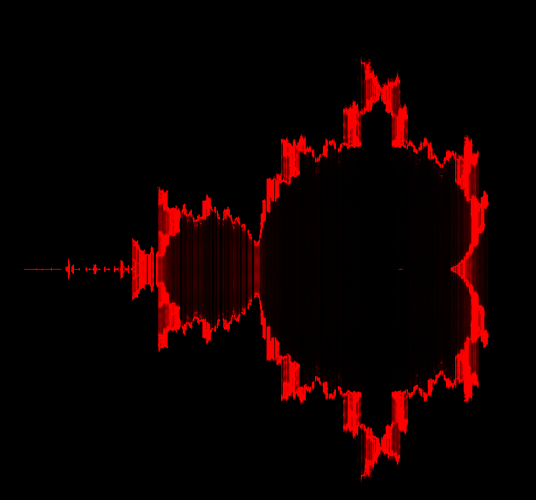This was a very bad first attempt at a mandelbrot for Oscistudio Livecoding.
Once I’m a bit more comfortable with LC I may try to make an animation out of it.
The biggest problem with it is that it the path you see is not traversed in a sensible way (right to left, top to bottom). Having spoken to a friend I’m going to try and get it to follow a sensible path (I’ve been told a recursive algorithm is a good shout).
Anyway, mess around with it and tell me what you think:
/*
Very bad implementation of a mandelbrot for Oscistudio.
Set the frequency of the channel to be very low (well below 1) for best viewing.
Turn up the afterglow in settings as well if you want the image to persist.
Enjoy!
WalkingWave
*/
#include<PathRecorder.h>
float scale=4;// size of a side of the image/coordinate box to use
vec3 offset; // bottom left coordinate of coordinate box
#define resolution 12000
cmplxf points[resolution][resolution];
bool good[resolution][resolution];
PathRecorder<150000> vecs;
//declare functions
void setup(); //run on startup
void update();// built in. run every frame?
cmplxf cmulf(cmplxf a,cmplxf b); // for multiplying complex numbers together
bool mandelbrot_test(cmplxf z,int depth); // test if a point is in the set up to depth iterations
vec3 gen(float t);//built in
void update(){ //don't need it
}
void setup(){
offset = {-scale/2,-scale/2};//coordinate of bottom left of the box
//now go through each point in the coordinate box and add it to the path recorder if it is in the set:
for(int j=0;j<resolution;j++){// for each row
for(int i=0;i<resolution;i++){ // for each column
cmplxf z={offset.x+(scale*i)/resolution,offset.y+(scale*j)/resolution};// change coordinate: x,y to Re(),Im() and fit to box
points[j][i]=z;
if(mandelbrot_test(z,20)){
//If a point is in the set set the boolean for that location to true
good[j][i]=true;
}
else{
good[j][i]=false;
}
}
}
//cleanup. We need to remove interior points by rejecting completetly surrounded points:
for(int i=1;i<resolution-1;i++){
for(int j=1;j<resolution-1;j++){
if(good[j][i]){
if(good[j-1][i]==true&&good[j+1][i]==true&&good[j][i-1]==true&&good[j][i+1]==true&&good[j-1][i+1]==true&&good[j-1][i-1]==true&&good[j+1][i-1]==true&&good[j+1][i+1]==true){
continue;
}
else{
vecs.add({points[j][i].r,points[j][i].i});
}
}
}
}
}
cmplxf cmulf(cmplxf a,cmplxf b){
cmplxf *res;
return {b.r * a.r - b.i * a.i,b.r * a.i + b.i * a.r};
}
cmplxf cadd(cmplxf a,cmplxf b){
return {a.r+b.r,a.i+b.i};
}
bool mandelbrot_test(cmplxf c,int depth){
cmplxf z = {0,0};
bool res=true;
while(depth>0){
z=cadd(cmulf(z,z),c);
if((z.r*z.r+z.i*z.i)>4){
res=false;
break;
}
depth--;
}
return res;
}
vec3 gen(float t){
return vecs.gen(t,false)*0.5+vec3{0.25,0};//Use the pathrecorders .gen method to get it to spit out a point for each value of t.
}

